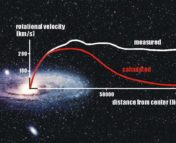Title: A Second Galaxy Missing Dark Matter in the NGC 1052 Group
Authors: Pieter Van Dokkum, Shany Danieli, Roberto Abraham, Charlie Conroy, Aaron J. Romanowsky
First Author’s Institution: Astronomy Department, Yale University, New Haven, CT, USA
Status: Submitted to the Astrophysical Journal Letters, open access on arXiv
Last March, a team of astronomers led by Pieter van Dokkum announced the discovery of a galaxy with almost no dark matter at all (for a great summary of the original discovery, check out this astrobite). The leading theories of galaxy formation rely on a significant dark matter component, known as a dark matter halo, to create a galaxy, so this unexpected observational result naturally sparked a healthy amount of debate and discussion, both in the Twittersphere and in subsequent publications (and we have an astrobite for that too!). Since then, the original results have been scrutinized, criticized, and defended, and multiple follow-up studies have been conducted to try and provide additional evidence for or against the discovery. Today we discuss the latest exciting development in this ongoing saga: the discovery of a second galaxy that is also severely deficient in dark matter.

Figure 1. The Dragonfly image of the surrounding area of NGC 1052. The two galaxies that have been identified as dark matter deficient have been highlighted and zoomed-in images of them from the Hubble Space Telescope are shown in the insets (Figure 4 in the paper).
A quick refresher on how we got here
Galaxies are a bit like icebergs: the part we can see is very small compared to the part that is hidden. For galaxies, it is possible to generate a rough estimate of the amount of visible, or baryonic, matter by adding up all of the light we receive and converting it into an equivalent stellar mass (there are many caveats to this estimate, as it depends strongly on which types of stars are responsible for the majority of the galaxy’s light, but all we need here is a rough estimate).
However, the stellar mass is just the tip of the galactic iceberg. It is possible to measure the total mass of the galaxy (including matter that does not emit light like a star), by measuring how fast things are moving in and around it due to the influence of gravity. For a spiral galaxy like the Milky Way, in which most objects are rotating in the same direction, estimating the mass is a simple as measuring the circular velocity of objects far from the center and applying the virial theorem to obtain the mass. In elliptical and dwarf galaxies, the stars are moving in random directions and the average velocity may be near zero, but it is possible to take advantage of the velocity dispersion to produce a similar estimate of the total mass. Because this mass estimate involves measuring how things move in galaxy, it is called the galaxy’s dynamical mass.
It turns out that a galaxy’s dynamical mass is typically at least 5-10 times — and in some cases up to several hundred times — larger than its stellar mass. The reason for this huge discrepancy, according to most astronomers, is the presence of a large, completely invisible component of the galaxy called a dark matter halo. Our current understanding of galaxy formation and large-scale structure is rooted in the assumption that all galaxies form within dark matter halos (alternatively, some prefer to do away with dark matter and instead tweak the fundamental physics with theories like Modified Newtonian Dynamics or Modified Gravity).
One way or another, the large dynamical mass-to-light ratio is currently viewed as a defining characteristic of a galaxy. It therefore came as quite a surprise last March when van Dokkum et al. announced the discovery of a galaxy named NGC1052-DF2 with almost no dark matter at all! By measuring the velocities of globular clusters orbiting DF2, the authors were able to show that the stellar mass and the dynamical mass had nearly the same value.
The unexpected discovery received significant amount of backlash; everything from the statistics in the original paper to the use of globular clusters as tracers was called into question, and even the hype the paper received drew some criticism. Between then and now, several important follow-up studies were conducted by the original team in an attempt to bolster their results. Particularly noteworthy is a paper published earlier this month that used observations from the Keck telescope to estimate the dynamical mass of DF2 in an independent manner, by measuring the velocity dispersion from diffuse stellar light instead of globular clusters. The final result from this paper was fully consistent with the original dynamical mass measured for DF2 using globular clusters, further strengthening the original conclusion.
But after the many follow-ups, one central concern still remained for van Dokkum’s group — what if this galaxy was just a statistical fluke? Perhaps DF2 is simply a satellite galaxy that has already undergone tidal stripping and lost most of its dark matter; if such a galaxy lay on a very specific orbit, our viewing angle might lead to its classification as an ultra-diffuse galaxy with very little dark matter. Drawing any serious conclusions about galaxy formation and evolution from just one galaxy made even the original authors uncomfortable. That is, until they found…
… Another galaxy lacking dark matter!
In today’s paper, van Dokkum et al. report the discovery of a second galaxy with little to no dark matter, named NGC1052-DF4 (see Figure 2). It resides in the same group as DF2, and was discovered by the same instrument that was used to study DF2: the Dragonfly Telephoto Array.

Figure 2. Zoomed-in image from the Hubble Space Telescope of NGC1052-DF4. The seven globular clusters whose velocities were used to estimate the dynamical mass of the galaxy have been tagged and are shown close-up in the small panels on the right-hand side (Figure 1 in the paper).
To estimate the dynamical mass of DF4, the authors again measured the velocity dispersion of its globular clusters, just as they did in the case of DF2. Figure 2 also points out the locations of the seven globular clusters around DF4 whose velocities were measured in order to calculate the dynamical mass, and Figure 3 displays the constraints on the velocity dispersion (and therefore by extension on the dynamical mass itself) from these seven globular clusters.
As shown in Figure 3, the observed velocity dispersion, centered around ~4 km/s, is fully consistent with that of a galaxy consisting of only stars and no dark matter. Meanwhile, the expected velocity dispersion of a galaxy the size of DF4 that also has a typical dark matter component is ~30 km/s, which is very strongly disfavored by these observations.

Figure 3. Constraints on the velocity dispersion of NGC1052-DF4 from the seven globular clusters. The solid and the dashed lines represent two different approaches used by the authors to perform the statistical analysis, and both suggest a velocity dispersion of approximately 4 km/s. The vertical dotted line represents the expected velocity dispersion from DF4’s stellar mass alone (approximately 7 km/s), comfortably within the 1-sigma range for the observed velocity dispersion. The expected dispersion for a normal dark matter halo with the observed stellar mass is approximately 30 km/s, which is highly disfavored in this analysis (Right panel of Figure 3 in the paper).
Many questions and concerns still remain, and the next item the authors plan to investigate is why both DF2 and DF4 seem to have such a uniquely numerous and bright population of globular clusters. But with these most recent observations, the authors can now boast two galaxies within the same galaxy group that seem to be severely dark matter-deficient. For both of them to be a statistical anomaly is significantly less likely than before DF4 was discovered. The authors conclude on the optimistic note that “one is an exception and two is a population.”
If true, the confirmation of a new population of galaxies like DF2 and DF4 could raise many interesting questions about our understanding of how these galaxies form: did a past encounter with another galaxy cause the stellar and the dark matter components to separate? Is tidal stripping by a larger galaxy a possible mechanism for this? Could it have formed without any dark matter in the first place?
The discussion about galaxies that lack dark matter and their possible origins is still far from being resolved. While we wait for additional observations and papers scrutinizing these latest results, Twitter provides plenty of interesting discussions to keep us occupied (see here for a very recent example). Yet amid the new discoveries and the lingering concerns, one thing seems absolutely certain: the glorious process of scientific discourse will continue to unfold, and all we have to do is sit tight and enjoy the ride.




